A wonderful experience is growing apples at home. Even in small areas, there are many choices to choose from. Apple trees grow quickly, are easily cultivated in much of the United States, and produce fruit in a few years.
There are 7,500 varieties of apples worldwide, but only 2,500 types are farmed in the United States. With so much variety available, picking which kind of apple tree to plant can be a little challenging. By reviewing a list of criteria, you may make your decision easier.
Just A Few Requirements
This section is for you if you have ever tried to grow apple trees but were disappointed when they didn’t produce enough fruit.
It’s surprising how complicated it is to grow apple trees. But if you know the fundamentals, you can quickly anticipate abundant crops of tasty apples.
Growing Zones
Apple trees are adaptable to a wide range of climates but generally perform best in temperate regions with distinct seasons. While some apple varieties can withstand colder temperatures, others thrive in warmer climates. In the United States, apple trees can be grown in zones 3 to 9, encompassing a broad spectrum of climates.
Chill hours refer to the number of hours a fruit tree needs to be exposed to temperatures between 32°F (0°C) and 45°F (7°C) during its dormant period in winter. This chilling requirement is essential for many fruit trees, including apple trees, as it helps trigger their growth and flowering in the spring.
Chill hour
The specific chill hour requirements can vary depending on the apple tree variety. Some varieties require fewer chill hours, while others need more. Generally, most apple varieties require between 500 to 1,000 chill hours to break dormancy and bloom properly.
It’s essential to choose apple tree varieties that are well-suited to the chill hour accumulation in your specific climate zone. If the chill hour requirements are not met, it can result in poor flowering, reduced fruit set, and irregular fruit development.
To determine the chill hour accumulation in your area, you can consult with local agricultural extension offices or use online resources that provide chill hour data for different regions. This information can help you select the right apple tree varieties for your location and ensure successful fruit production.
Flowering Group
Apple trees bloom at different times of the year, so you’ll need to choose trees that bloom at the same time because most require cross-pollination between at least two varieties of apples.
| Flowering Group | Pollinated By |
| 1 | 1 and 2 |
| 2 | 1, 2, and 3 |
| 3 | 2, 3, and 4 |
| 4 | 3, 4 and 5 |
| 5 | 4, 5, and 6 |
| 6 | 5, 6, and 7 |
| 7 | 6 |
Popular Types of Apple Trees
1. Gravenstein
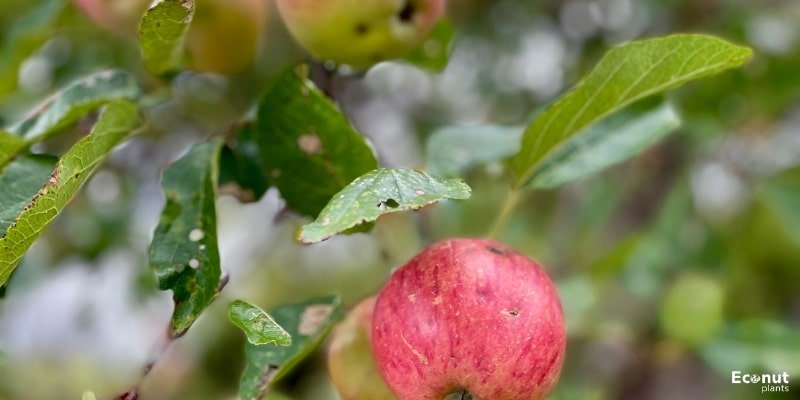
Flowering Group: 1
Chill Hours: 700
Height: 15–20 feet
Growing Zones: USDA zones 2-9
Apples known by their loving name, Gravs, are among the first to reach the market every year, ripening in late July. Grav apples make wonderful pies, sauces, and baked items, depending on how ripe the fruit is. Apple cider is very delicious with its tart flavour.
July and August are fruit-harvesting months. Notably, there is limited shipping of these apples because of their poor storage quality. Gravenstein apples are probably only going to taste well if you grow them yourself or if there is an orchard nearby.
2. Idared
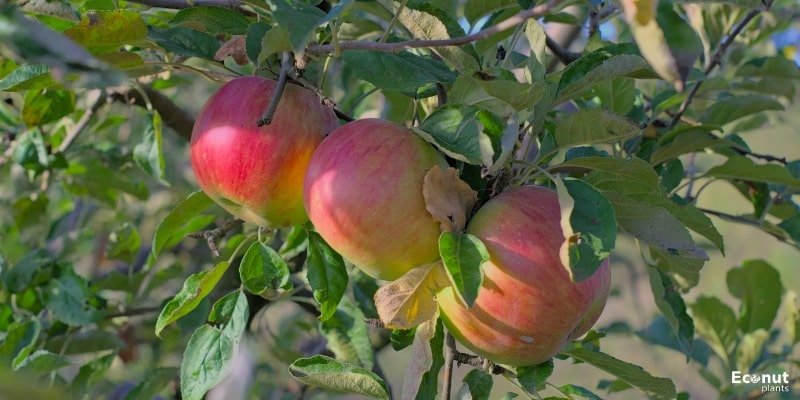
Flowering Group: 1
Chill Hours: 800
Height: 12-16 feet
Growing Zones: USDA zones 2-5
Idareds keep their shape flawlessly and present a beautiful presentation on the table, making them a wonderful choice for those who enjoy the timeless sweetness of baked apples. Originating in Penn Yan in 1791, the hybridized apple was created in Idaho by crossing two traditional New York varieties, Wagener and Jonathan.
3. Anna

Flowering Group: 2
Chill Hours: 250-300
Height: 15-20 feet
Growing Zones: USDA zones 6-9
Anna apple trees are another favourite in the South; they grow well in the home and are prolific growers. The tree was originally created at the Israeli kibbutz Ein Shemer. It was intended to grow in areas with little chance of freezing temperatures because it is a low-chill habitat. In orchards in California, Texas, Florida, and other Gulf states, you can find Anna apple trees.
Annas are related to the Golden Delicious apple, although they taste and look more like Honeycrisp or Granny Smith apples. These apples are great to eat, sweet, and mildly acidic, making them suitable for baking and sauces. In June and early July, a bountiful harvest is anticipated.
4. Dorsett Golden

Flowering Group: 2
Chill Hours: 100-300
Height: 15-20 feet
Growing Zones: USDA zones 5-9
Assembled in Dorset another apple variety created for tropical climates is the golden one. In actuality, the tree was originally introduced to the US in 1950 following its successful growth in the Bahamas.
This apple cultivar, a descendant of the Golden Delicious, needs the least amount of cold of any apple tree and grows best in warm climates. The tree grows and bears fruit even in the hot, humid climate of southern Florida, although specialists are still unable to agree on the precise number of cool hours needed.
The Dorsett Golden should produce a large crop. Though even sweeter and more tasty than a Golden Delicious, the fruit is pale green to yellow in colour. Not only does it keep well in sweets, but it also makes a great eating apple.
5. Ein Shemer
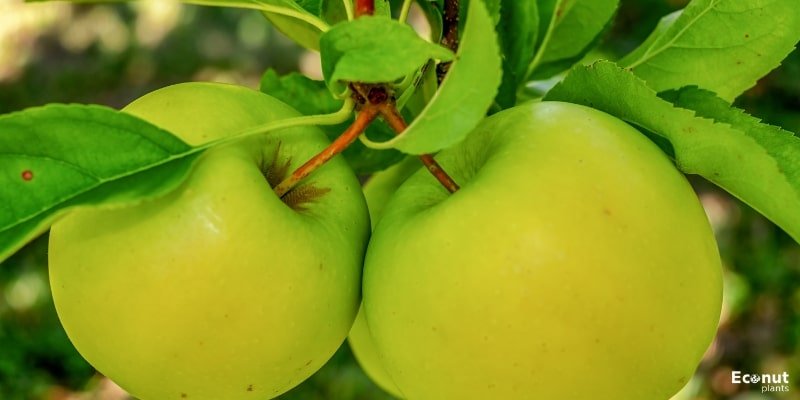
Flowering Group: 2
Chill Hours: 350
Height: 12-15 feet
Growing Zones: USDA zones 3-5
This low-chilling cultivar thrives in warm to hot climates because it was bred in Israel. The huge fruit has a juicy, sweet flavour akin to that of a Golden Delicious. Although the tree is occasionally advertised as self-fertile, quality and productivity are enhanced by the pollen of an Anna apple that is nearby.
6. Hidden Rose

Flowering Group: 2
Chill Hours: 2,100
Height: 13–16 feet tall
Growing Zones: USDA zones 4
This variety’s stunning pink skin has made it quite a social media phenomenon. A couple on their property found the “parent tree” of this unusual apple a short distance from an abandoned well.
Currently under trademark as “Hidden Rose Apples,” they are grown solely by Thomas Paine Farms in Kings Valley, Oregon, a short distance from the location of the original parent tree. It has a primarily sweet, somewhat acidic flavour with a strawberry-lemonade undertone.
7. Fuji

Flowering Group: 3
Chill Hours: 200-400
Height: 8-10 feet
Growing Zones: USDA zones 6-9
This Japanese apple cultivar is a late-season, low-chill apple that can be grown in regions with warmer winters. The meat is juicy, crisp, sweet, and firm. Powdery mildew is not able to harm the tree.
8. Pink Lady
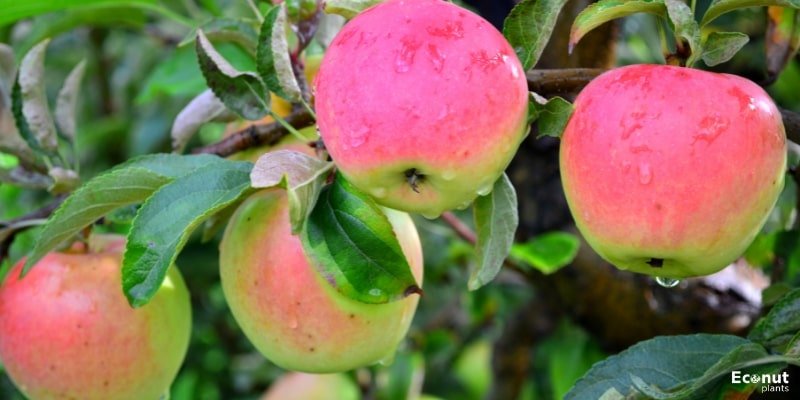
Flowering Group: 3
Chill Hours: 300-600
Height: 20-25 feet
Growing Zones: USDA zones 6-9
The first apple variety to be sold with a brand name was Pink Lady. The action started a trend of apple name trademarks, enabling groups and breeders to maintain quality control and make money from each apple sold.
9. Winesap
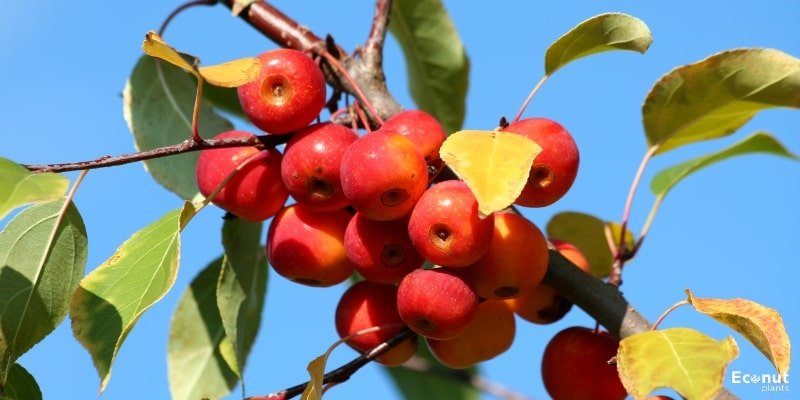
Flowering Group: 3
Chill Hours: 500 – 800
Height: 10–25 ft
Growing Zones: USDA zones 5-8
The flavour of the Winesap apple is a little different from regular apples; it tastes like wine and is extremely peppery. The smell of the petals and the fruit is nice, which is why I like it. As I immerse my face in the petals, I’m shocked that my honeybees have not stung me!
Though less well-known, this heirloom apple variety is well-liked by producers in both the north and the south. It was developed in New Jersey. It works well for ciders, sauces, and preserves and is hardy in zones 5 through 8. If you’re searching for a somewhat unusual flavour, they’re also excellent fresh.
10. Cortland
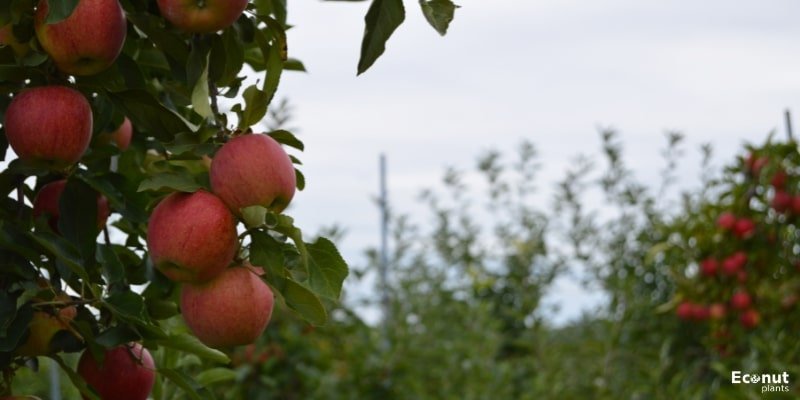
Flowering Group: 3
Chill Hours: 800-1000
Height: 297 feet
Growing Zones: USDA zones 4-6
The Cortland apple variety is descended from the McIntosh apple, which is responsible for its vivid red colour. Its juicy, crisp white flesh has a flavour that is a blend of sweet and acidic. This cold-hardy apple variety’s unique quality is that when it is cut, the flesh does not brown as quickly.
11. Empire

Flowering Group: 3
Chill Hours: 200-800
Height: 12-16 feet
Growing Zones: USDA zones 4-7
Empire apples have a better flavour and colour than McIntosh apples. Lester C.’s 1944 seed was the source of the apple cultivar used in the Empire apple trees. Anderson, a fruit nutritionist at Cornell. The original seed was a cross between McIntosh and Red Delicious.
The Empire apple has a dark red colour with a heavy, waxy bloom and crisp, juicy flesh with some aromatic quality. Empire apples make a unique, rosy apple sauce .When baked, they frequently get mushy very soon. Best for fresh eating. Fruit hangs on trees longer than McIntosh but drops plenty before fully ripe. The Empire apple tree yields consistently every year.
12. Gala
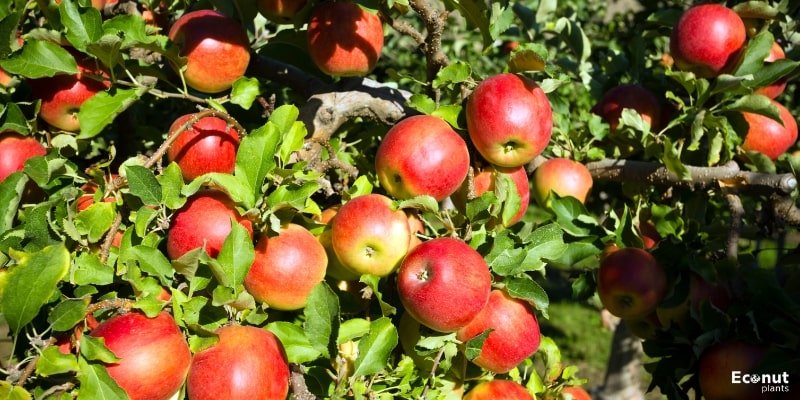
Flowering Group: 4
Chill Hours: 500
Height: 18-25 feet
Growing Zones: USDA zones 4-10
The sweet and crisp flavour of Gala apples makes them a popular and extensively farmed apple type. One of the world’s most commercially successful apple cultivars, they were first introduced in New Zealand during the 1930s. Gala apples taste mildly fragrant and have a characteristic yellow-to-orange peel with crimson stripes.
Though their versatility makes them wonderful for various culinary applications, including salads, desserts, and snacks, they are also frequently enjoyed fresh. Gala apples are a popular option for both eating raw and cooking because of their exceptional juiciness.
13. Red Delicious
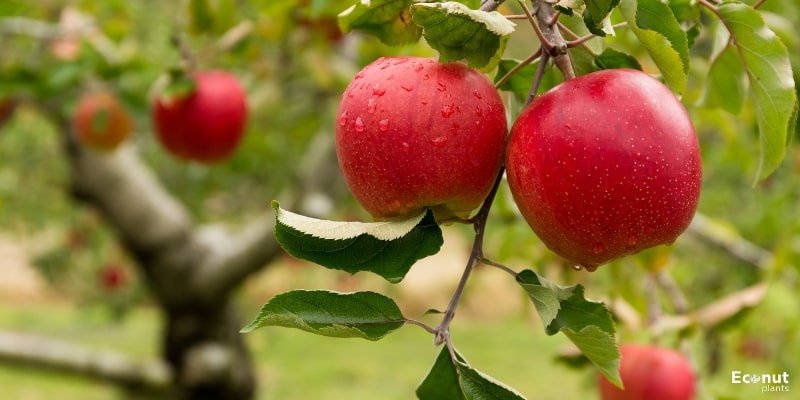
Flowering Group: 4
Chill Hours: 700-800
Height: 20-25 feet
Growing Zones: USDA zones 6-10
Red Delicious apples were found in Iowa in the 1870s, and they are an older relative of their golden counterparts. They possess the characteristic red hue and unique apple taste that we identify with the fruit. It’s possible that any candy you’ve ever had that had an apple flavour was inspired by Red Delicious.
14. Braeburn
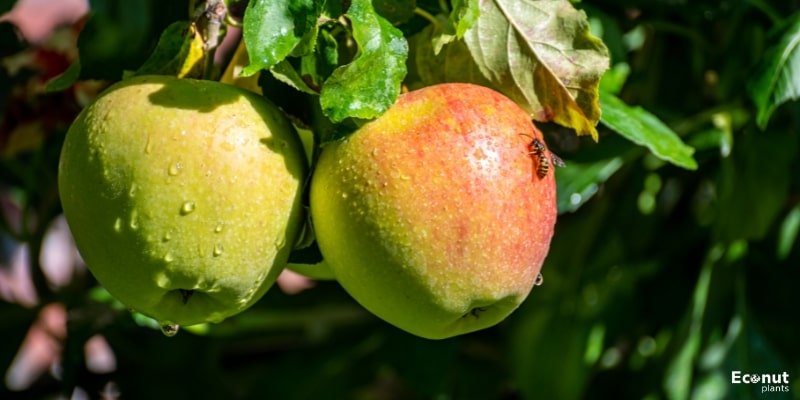
Flowering Group: 4
Chill Hours: 700
Height: 12-15 feet
Growing Zones: USDA zones 5-8
Massive yields of bi-coloured, smooth-skinned, crisp, delicious apples are produced by Apple Braeburn trees. Easy to cultivate, early to crop from an early age, and high storage capability are the reasons behind the popularity of this well-known variety.
Stored for up to 4 months, the heavy crops of flavourful apples can be picked in October.
New Zealand’s Braeburn Orchard is where braeburn apples, which belong to the Rosaceae family botanically, were first found to be growing in 1952. Due to the fact that they are chance seedlings, nature produced them rather than artificial breeding.
The crisp, juicy, light yellow to gold flesh of the Braeburn apple has a tangy flavour that is counterbalanced by a hint of sweetness. It also has a few dark brown seeds in the center of the fibrous core.
The first commercially produced modern apple variety with flavour that could truly compete with the more traditional kinds was Braeburn.
15. Baldwin
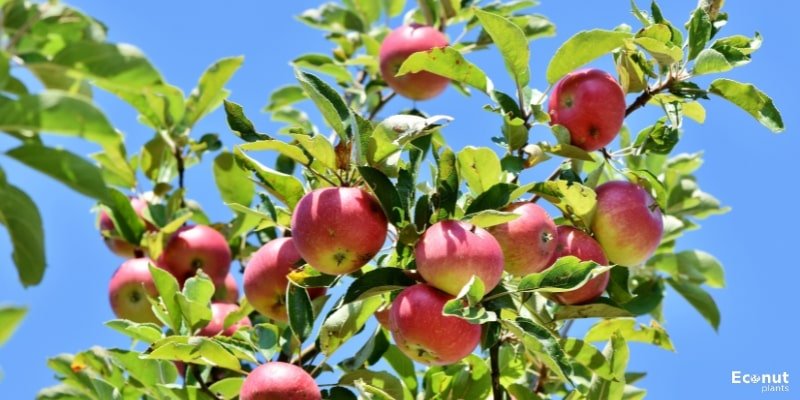
Flowering Group: 4
Chill Hours: 150 chill hours
Height: 15–25 feet
Growing Zones: USDA zones 5-9
Baldwin is among the oldest and best apples from New England. Its skin is coppery green with crimson-red undersides, making it big and conical. Its creamy white flesh has a crisp, juicy texture. When cooked, it maintains its shape and has a spicy, sweet-tart flavour.
It is aromatic. Not only is it a delicious apple when eaten raw, but it also bakes well, particularly in pies. Baldwins is a good store. Baldwin is a superb choice for cider as well as fresh eating and cooking apples. Between October and November, Baldwin is available for harvesting.
16. Jonagold

Flowering Group: 4
Chill Hours: 800
Height: 8-10 feet
Growing Zones: USDA zones 3-8
Another excellent apple variety from the Fruit Testing Station is the Jonagold apple tree. It is currently commonly grown and is a hybrid between the Jonathan and the Golden Delicious. The Jonagold apple often has huge fruit with yellow-green skin and a scarlet flush.
Juicy, crumbly flesh with a cream tint. Jonagold apples are delicious on their own and work well in pies and sauces. The apple tree, known as Jonagold, is robust, invasive, and prolific. For pollination, take into account Liberty and/or White Pearmain.
17. Jonafree
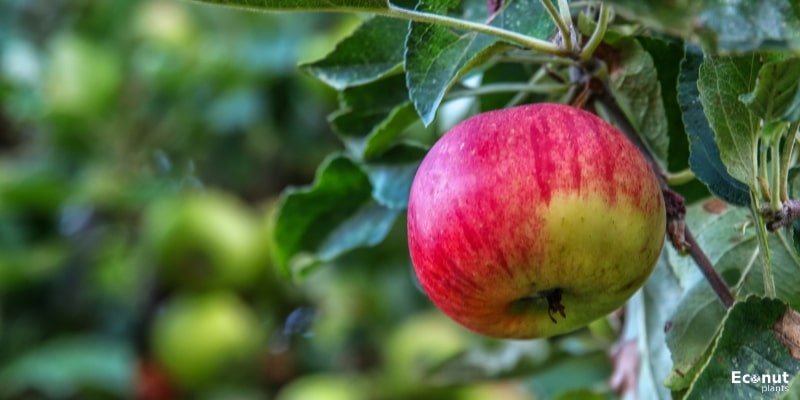
Flowering Group: 4
Chill Hours: 800
Height: 12-15 feet
Growing Zones: USDA zones 5-8
A freewheeling apple tree, Jonathan. This hardy cultivar is less prone to blight, rust, and mildew than other Jonathans, and it is resistant to apple scab. bears large, acid-free Jonathan fruit in copious bunches.
Traces its roots back to 1972 in Urbana, Illinois. ripens in the middle of September. Another variety of apple is needed as a pollinator. The suggested pollinators are listed below.
18. Cosmic Crisp
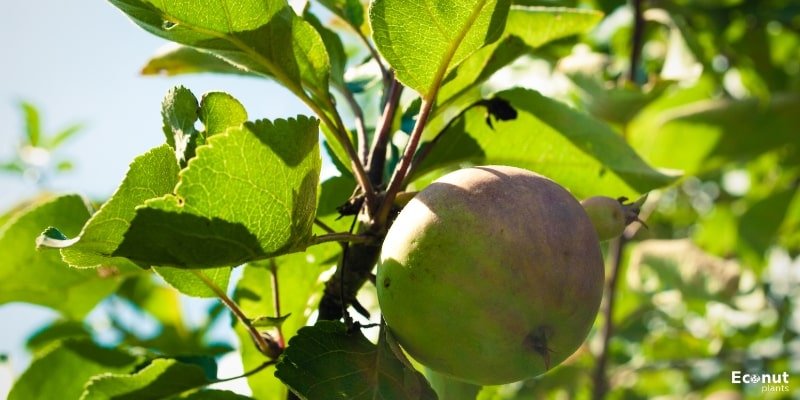
Flowering Group: 4
Chill Hours: 300
Height: 11-16 feet
Growing Zones: USDA zones 5-9
With Cosmic Crisp, Washington State University was able to witness the results of their 20 years of research. These huge, juicy apples, which are a hybrid between the Enterprise and Honeycrisp kinds, are just the right amount of tart and sweet. Moreover, the high amounts of acidity prevent the flesh from browning when it is cut.
19. Northern Spy

Flowering Group: 5
Chill Hours: 1,000
Height: 20-25 feet
Growing Zones: USDA zones 3-7
Growing apples in the north is a great alternative, as the name suggests, with Northern Spy apples. Because it’s sweet, fruit goes well with sauces and desserts. Making cider and apple cider donuts is another common use for it. When kept refrigerated, apples can be stored for three months.
Given that late-season frost can destroy delicate blossoms, Northern Spy trees are late bloomers. Consider harvesting a little later in the fall as a result. The tree is extremely prone to fire blight, yet it is not resistant to rust and can withstand cold weather.
20. Court Pendu Plat
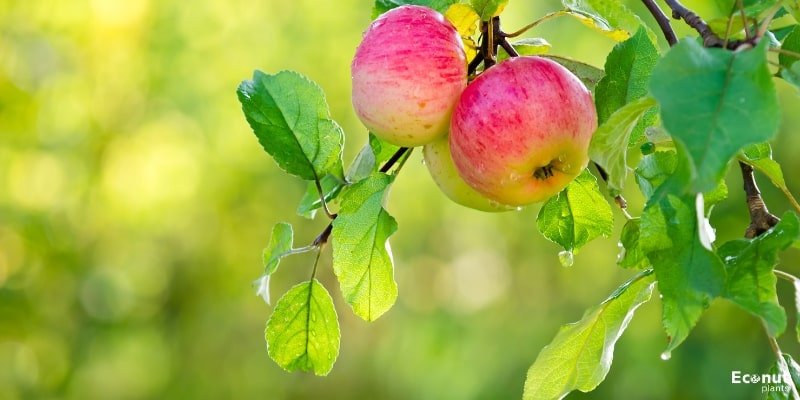
Flowering Group: 6
Chill Hours: 500
Height: 18 feet
Growing Zones: USDA zones 4-8
Court Pendu Plat apples have an oblate to round form and are attached to a short, fibrous stem. They have a characteristic, wide, and flattened appearance. The base is yellow-green, flushed with striping and spots of reddish-orange blush, and the skin is semi-rough, with noticeable lenticels and faint russeting.
The cream-colored flesh is solid, dry, and finely grained beneath the surface, covering a central core that is loaded with tiny, black-brown seeds. Apples from Court Pendu Plat have a balanced sweetness and acidity, with a delicious and slightly nutty flavour. They are also aromatic. With storage, the sweetness level will also rise and take on softer, pear-like notes.
21. Sweet Sixteen
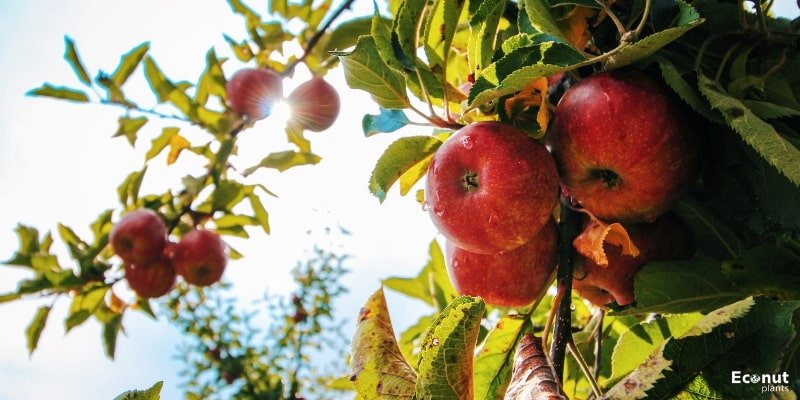
Flowering Group: 3
Chill Hours: 1100-1400
Height: 20-30 feet
Growing Zones: USDA zones 3-9
The University of Minnesota bred Northern Spy and Frostbite apples to create Sweet Sixteen apples. The end product was an early-blooming, cold-hardy tree.
Regretfully, the new cultivar has never been grown commercially because the institution forgot to file a patent for it. It contained no money at all. Having said that, home gardeners and small growers with a variety of orchards have been drawn to the distinct flavour. If you’re lucky, you might be able to discover these beauties at your local farmers’ market.

